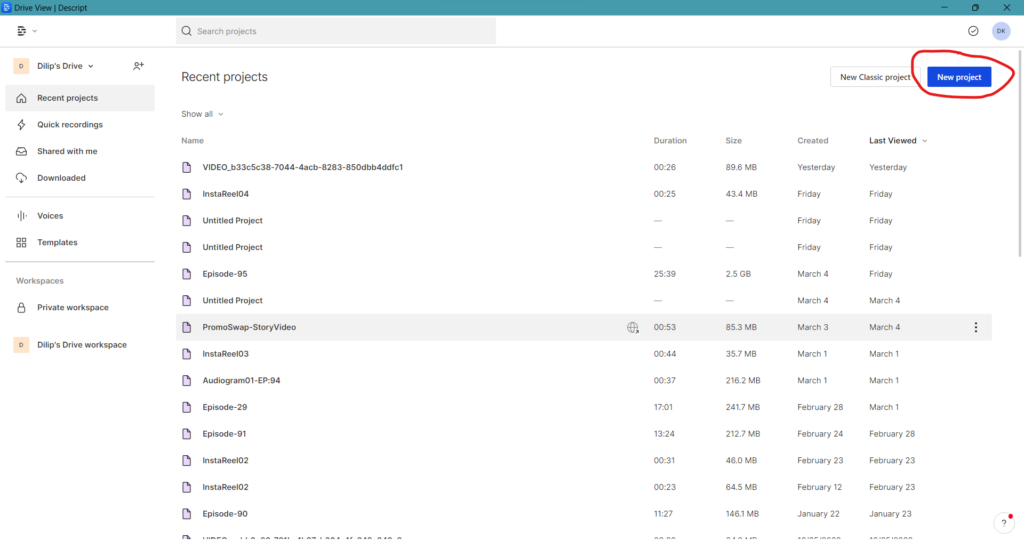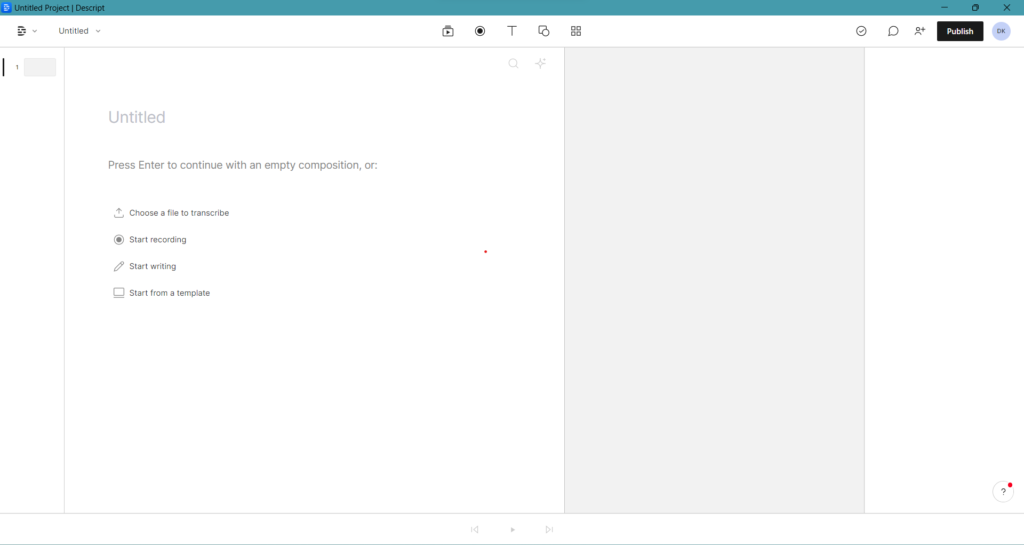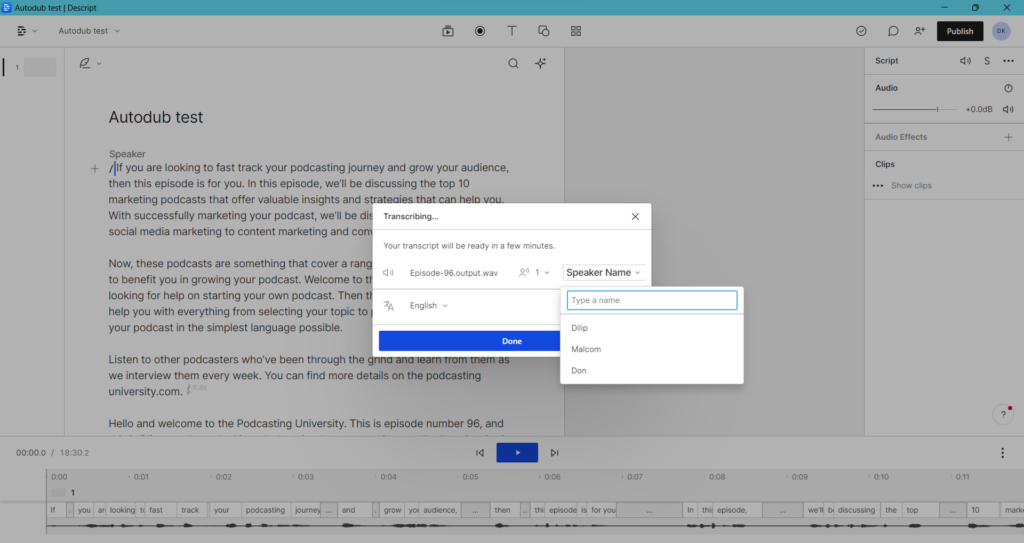This Descript review will be especially helpful for you if you are still trying to figure out how to simplify your podcast episode editing process. Editing is one of the most important aspects of podcasting. But it can sometimes...
This Descript review will be especially helpful for you if you are still trying to figure out how to simplify your podcast episode editing process.
Editing is one of the most important aspects of podcasting. But it can sometimes be extremely overwhelming, especially with all of the information that is available online.
While using a conventional DAW (Digitial Audio Workstation) which is another name for the editing software, is the norm, for newbies, it can be a herculean task to understand the individual steps involved in editing using this software.
And that is where some of the unconventional software like Descript comes in.
If you’re a new podcaster who’s struggling to edit your audio, then you might want to consider using Descript.
This amazing podcast editing software is designed to make podcast editing easy, intuitive, and efficient.
With Descript, you can quickly and easily edit your audio, remove mistakes, refine your content, and publish your podcast without any hassle.
In this detailed Descript review, I will give you a detailed walkthrough of the Descript app and also tell you the pros and cons of using it.
What is Descript?
Descript is a cloud-based audio and video editing software that uses AI to transcribe, edit, and mix your audio files. The software works by analyzing your audio and converting it into text, which you can then edit using a simple and intuitive dashboard.
With Descript, you can edit your audio like you would edit a text document, making it easy to remove mistakes, insert new content, and refine your podcast.
Why is Descript a great tool for new podcasters?
Descript is a great tool for new podcasters because it’s incredibly easy to use. Unlike other podcast editing software, Descript has a simple and intuitive interface that makes it easy to edit your audio. You don’t need to be a technical expert or have any previous experience in audio editing to use Descript. With just a few clicks, you can edit your audio, refine your content, and publish your podcast.
Another great feature of Descript is its AI-powered transcription.
Descript can transcribe your audio files automatically, saving you time and effort. You can then edit the transcription like you would edit a text document, making it easy to remove mistakes, insert new content, and refine your podcast.
Descript also offers a range of editing tools that make it easy to enhance your podcast. For example, you can use the software to remove unwanted noise, adjust the volume, add music and sound effects, and more. You can also use Descript to collaborate with others, making it easy to work with co-hosts or guests.
Descript Software Walkthrough
Before we get into the detailed Descript review, let me quickly show you a walkthrough of the Descript Software.
Descript is a special software when it comes to audio editing. Unlike most DAWs (Digital Audio Workstations, which is another name for audio editors) which edits audio by editing the waveform timeline, Descript edits audio using a textual editing method.
It edits audio just like you will edit a word document. If you want to remove a part, simply delete it. That’s it!
Another thing that you need to keep in mind is that Descript is desktop software but all of the editing and storage happens on the cloud. So you need to have an internet connection if you want to access all of its features.
Let me show you a quick walkthrough of how this software looks and what aspects you need to stay aware of if you are planning to use it to edit your podcasts.
The Workspace
The dashboard is simple and shows you all of your recent projects in an easy-to-access window.
All of the folders that you will need quick access to are neatly arranged on the left-hand sidebar.

In order to start all you need to do is click on “New Project” and get started!
There is another option “New Classic Project” which is nothing but an older module that involved only audio editing. The newer module also had video editing.
This can be a bit confusing, but I recommend that you ignore that option and use the “New Project” option only!
The Editor
The editor is again extremely simple to use.
You will see 4 pretty straightforward option which are –
Choose a file to transcribe Start recording Start writing Start from a template
If you are editing a pre-recorded audio then all you need is to drag and drop the file onto the left-hand side of the editor or, click on “choose a file to transcribe” and then select the file.
But if you want to record an episode, you can do that as well in Descript. Just click “start recording” and record your episode.
The other two options are slightly advanced but can be extremely handy once you learn them. Descript has a powerful feature called “Overdub” which is an AI that can talk exactly like you once you train it on your style of speaking.
Descript also has a few inbuild voices that you can use to record scripts.
You can use Overdub and record audio snippets by selecting the “start writing” option.
The Editing Board
The editing dashboard is where you edit your episodes.
The latest version of Descript offers you a powerful feature of storyboarding if you are into video and you want to use Descript for video editing.
And the best part is you can do both the audio and video editing on this single editing board.
In fact, you can create a video from your podcast episode by using one of the many stock videos available within Descript.
Once you have uploaded your audio file, Descript transcribes your episode which can take a few seconds.

Once the transcription is done, you will have to select a speaker name if it is a monologue. But if it is an interview episode you can let Descript detect the number of speakers and once it is done, you can select the names of the speakers in the episode and assign it to each voice.
The extreme left sidebar is for storyboarding which controls how your story is progressing. The next part, which is the biggest section of all is the trascript editor. It is here that you edit your transcript by either correcting it or, by editing it to edit your audio.
The next section (grey section in the above image) is where the video will appear if you are editing a video or, you want to add a video to your podcast.
The bottom section is where your audio waveform will appear, which can also be used to edit your audio. But why will you do it when you can easily edit it by editing your transcript?
The extreme right is where you find all of the options to fine tune your audio and video.
Editing Options
Descript has a lot of powerful editing options. You can make your audio sound like a studio recording, remove background noise, add background music, compress, level, etc.
You can practically do everything that you would do in any audio editor, in Descript too.
In fact, from a podcasting perspective what you get on Descript is more than enough.
This helps reduce the overwhelm that you feel with a conventional editor when you see all of those options on it.
Descript Review – Pros and Cons of Descript
I have been using Descript for about 8-9 months now. I started using it when they were in their earlier version which they have revamped completely with the new launch.
The newer version has a lot more features including storyboarding and is a lot easier in terms of usage.
While I didn’t find any cons in using Descript, I thought I should still be transparent and tell you what can be a con for a new user.
Here are the pros and cons of the Descript software.
The Pros of Descript App
Easy to use: Descript has a simple and intuitive interface that makes it easy to edit your audio. AI-powered transcription: Descript can transcribe your audio files automatically, saving you time and effort. Powerful editing tools: Descript offers a range of editing tools that make it easy to enhance your podcast. Collaboration features: Descript makes it easy to collaborate with others, making it ideal for co-hosts or guests.The Cons of Descript App
Steep learning curve: Descript has a bit of a learning curve, and it may take some time to get used to the software. Limited tutorial videos: There aren’t many tutorial videos available for Descript, which can make it difficult to learn the software.Descript Review – The Good, bad, and Ugly of Descript App
So should you go for Descript?
Is it worth the price and the hype?
Here’s my take on the Descript software and what I like and dislike about it.
Interface and Ease of Use
One of the most significant benefits of using Descript is its intuitive and user-friendly interface. The software is designed to be accessible and easy to navigate, even for those without prior editing experience.
The interface is sleek, and the layout is designed to provide all the necessary tools in one place.
The best part about Descript is that it takes away the overwhelm from audio and video editing, which is one of the biggest problems that a lot of new podcasters face.
Editing Tools
Descript offers a wide range of editing tools that can help podcasters create professional-sounding episodes.
The standout feature is the ability to edit audio by editing the text. Users can make changes to their podcast by editing the transcribed text, and the changes will automatically reflect in the audio.
This feature is especially helpful for those who prefer to edit by reading the text.
Another great tool is the ability to remove filler words automatically. Users can set a list of words to remove, such as “um” or “uh,” and Descript will automatically identify and remove them from the audio.
The “Studio Sound” option in Descript is excellent if you want to automatically remove background noise and make your audio sound like it was recorded in a studio.
It also gives you the option of using an equalizer, compressing your audio, leveling the volume, etc. which are all extremely handy when you are editing your podcast episode.
Collaboration
Podcasting is often a collaborative process, and Descript makes it easy to collaborate with others. Multiple people can work on the same project, and changes made by one person will be updated in real-time for others to see, provided you are connected to the internet.
So if you have an editing team that works on your audio, then it is extremely easy to collaborate with them on Descript.
Hosting and Publishing
While this isn’t something that I as a podcaster would use too often, the hosting feature in Descript can be handy if you want to publish your episode online and send a link to somebody.
Descript can publish your episodes directly to popular podcast hosting platforms like Blubrry, Buzzsprout, Castos etc. which can come in handy for podcasters.
Pricing
Descript offers both free and paid plans, with pricing starting at $15 per month for the Pro plan. The free plan includes up to three hours of transcription per month, while the paid plans offer unlimited transcription and additional features such as multi-track editing etc.
The PRO plan that offers all of the features starts at $24 per month if you pay annually.
You can get your copy of Descript here!
Conclusion – Descript Review
Overall, Descript is an excellent option for podcasters who want an easy-to-use, all-in-one editing solution. Its innovative editing tools, collaboration features, and hosting and publishing options make it a top contender in the podcasting software market. The software is not only affordable, but it’s also an excellent investment for anyone serious about podcasting.
Descript can be extremely helpful for new podcasters because it helps avoid the overwhelm of the editing process.
With its easy-to-use interface, AI-powered transcription, and powerful editing tools, Descript makes it easy to edit, refine, and publish your podcast.
While the learning curve can be a bit steep, Descript is still a great tool for anyone who wants to create high-quality podcasts without the hassle of using traditional audio editing software.
So, if you’re a new podcaster who’s looking for an easy, intuitive, and efficient way to edit your audio, then Descript is definitely worth checking out. Give it a try and see how it can help you create amazing podcasts!
If you are on Pinterest and if you liked this post, then do pin the below image.















